INFINITI Q50 2018 Service Manual
Manufacturer: INFINITI, Model Year: 2018, Model line: Q50, Model: INFINITI Q50 2018Pages: 458, PDF Size: 2.13 MB
Page 41 of 458
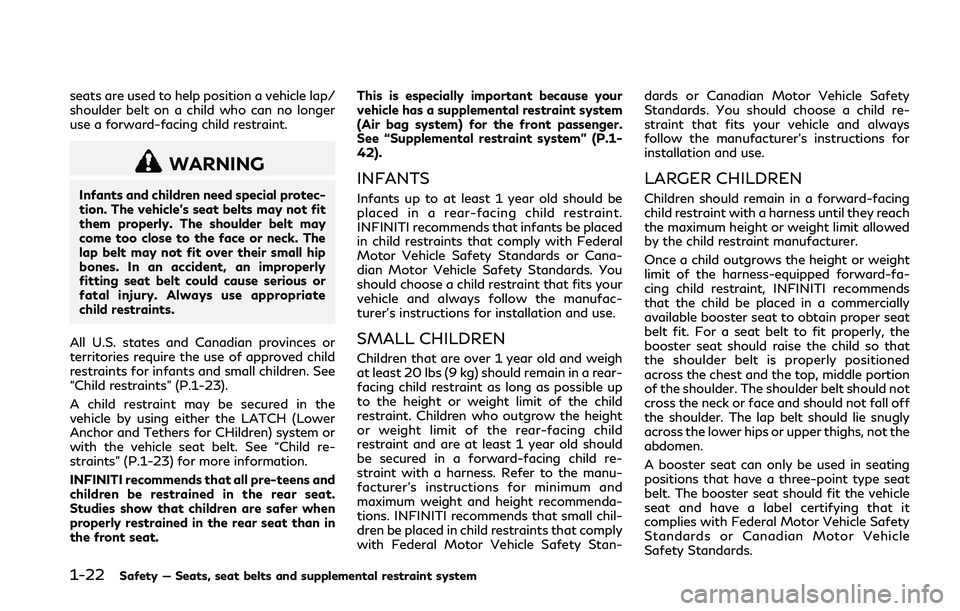
1-22Safety — Seats, seat belts and supplemental restraint system
seats are used to help position a vehicle lap/
shoulder belt on a child who can no longer
use a forward-facing child restraint.
WARNING
Infants and children need special protec-
tion. The vehicle’s seat belts may not fit
them properly. The shoulder belt may
come too close to the face or neck. The
lap belt may not fit over their small hip
bones. In an accident, an improperly
fitting seat belt could cause serious or
fatal injury. Always use appropriate
child restraints.
All U.S. states and Canadian provinces or
territories require the use of approved child
restraints for infants and small children. See
“Child restraints” (P.1-23).
A child restraint may be secured in the
vehicle by using either the LATCH (Lower
Anchor and Tethers for CHildren) system or
with the vehicle seat belt. See “Child re-
straints” (P.1-23) for more information.
INFINITI recommends that all pre-teens and
children be restrained in the rear seat.
Studies show that children are safer when
properly restrained in the rear seat than in
the front seat. This is especially important because your
vehicle has a supplemental restraint system
(Air bag system) for the front passenger.
See “Supplemental restraint system” (P.1-
42).INFANTS
Infants up to at least 1 year old should be
placed in a rear-facing child restraint.
INFINITI recommends that infants be placed
in child restraints that comply with Federal
Motor Vehicle Safety Standards or Cana-
dian Motor Vehicle Safety Standards. You
should choose a child restraint that fits your
vehicle and always follow the manufac-
turer’s instructions for installation and use.
SMALL CHILDREN
Children that are over 1 year old and weigh
at least 20 lbs (9 kg) should remain in a rear-
facing child restraint as long as possible up
to the height or weight limit of the child
restraint. Children who outgrow the height
or weight limit of the rear-facing child
restraint and are at least 1 year old should
be secured in a forward-facing child re-
straint with a harness. Refer to the manu-
facturer’s instructions for minimum and
maximum weight and height recommenda-
tions. INFINITI recommends that small chil-
dren be placed in child restraints that comply
with Federal Motor Vehicle Safety Stan-dards or Canadian Motor Vehicle Safety
Standards. You should choose a child re-
straint that fits your vehicle and always
follow the manufacturer’s instructions for
installation and use.
LARGER CHILDREN
Children should remain in a forward-facing
child restraint with a harness until they reach
the maximum height or weight limit allowed
by the child restraint manufacturer.
Once a child outgrows the height or weight
limit of the harness-equipped forward-fa-
cing child restraint, INFINITI recommends
that the child be placed in a commercially
available booster seat to obtain proper seat
belt fit. For a seat belt to fit properly, the
booster seat should raise the child so that
the shoulder belt is properly positioned
across the chest and the top, middle portion
of the shoulder. The shoulder belt should not
cross the neck or face and should not fall off
the shoulder. The lap belt should lie snugly
across the lower hips or upper thighs, not the
abdomen.
A booster seat can only be used in seating
positions that have a three-point type seat
belt. The booster seat should fit the vehicle
seat and have a label certifying that it
complies with Federal Motor Vehicle Safety
Standards or Canadian Motor Vehicle
Safety Standards.
Page 42 of 458

A booster seat should be used until the child
can pass the seat belt fit test below:
.Are the child’s back and hips against the
vehicle seatback?
. Is the child able to sit without slouching?
. Do the child’s knees bend easily over the
front edge of the seat with feet flat on
the floor?
. Can the child safely wear the seat belt
(lap belt low and snug across the hips
and shoulder belt across mid-chest and
shoulder)?
. Is the child able to use the properly
adjusted head restraint/headrest?
. Will the child be able to stay in position
for the entire ride?
JVR0473X
If you answered no to any of these ques-
tions, the child should remain in a booster
seat using a three-point type seat belt.
NOTE:
Laws in some communities may follow
different guidelines. Check local and state
regulations to confirm your child is using the
correct restraint system before traveling.
WARNING
Never let a child stand or kneel on any
seat and do not allow a child in the cargo
area. The child could be seriously injured
or killed in a sudden stop or collision.
SSS0099
SSS0100
Safety — Seats, seat belts and supplemental restraint system1-23
CHILD RESTRAINTS
Page 43 of 458
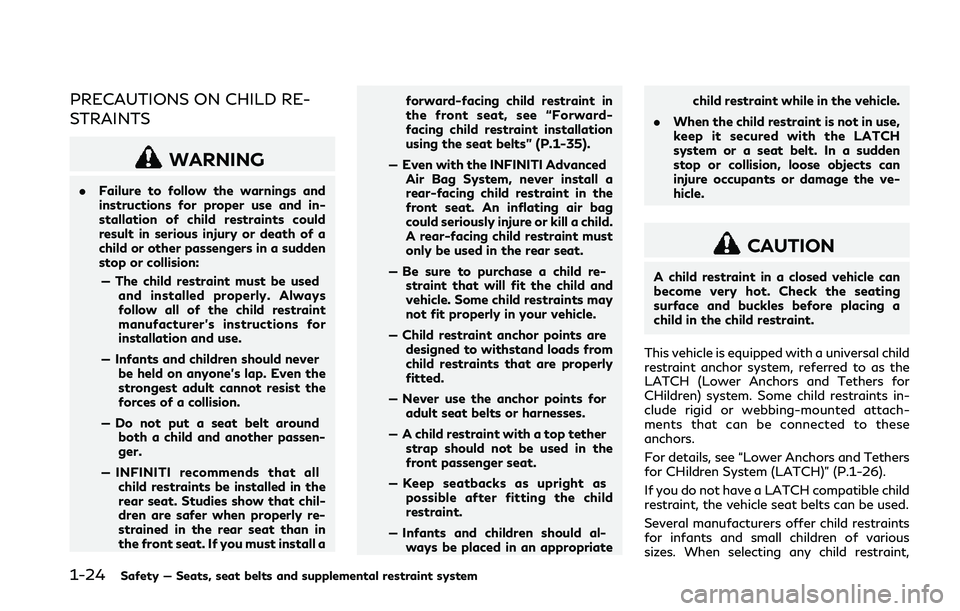
1-24Safety — Seats, seat belts and supplemental restraint system
PRECAUTIONS ON CHILD RE-
STRAINTS
WARNING
.Failure to follow the warnings and
instructions for proper use and in-
stallation of child restraints could
result in serious injury or death of a
child or other passengers in a sudden
stop or collision:
— The child restraint must be used and installed properly. Always
follow all of the child restraint
manufacturer’s instructions for
installation and use.
— Infants and children should never be held on anyone’s lap. Even the
strongest adult cannot resist the
forces of a collision.
— Do not put a seat belt around both a child and another passen-
ger.
— INFINITI recommends that all child restraints be installed in the
rear seat. Studies show that chil-
dren are safer when properly re-
strained in the rear seat than in
the front seat. If you must install a forward-facing child restraint in
the front seat, see “Forward-
facing child restraint installation
using the seat belts” (P.1-35).
— Even with the INFINITI Advanced Air Bag System, never install a
rear-facing child restraint in the
front seat. An inflating air bag
could seriously injure or kill a child.
A rear-facing child restraint must
only be used in the rear seat.
— Be sure to purchase a child re- straint that will fit the child and
vehicle. Some child restraints may
not fit properly in your vehicle.
— Child restraint anchor points are designed to withstand loads from
child restraints that are properly
fitted.
— Never use the anchor points for adult seat belts or harnesses.
— A child restraint with a top tether strap should not be used in the
front passenger seat.
— Keep seatbacks as upright as possible after fitting the child
restraint.
— Infants and children should al- ways be placed in an appropriate child restraint while in the vehicle.
. When the child restraint is not in use,
keep it secured with the LATCH
system or a seat belt. In a sudden
stop or collision, loose objects can
injure occupants or damage the ve-
hicle.
CAUTION
A child restraint in a closed vehicle can
become very hot. Check the seating
surface and buckles before placing a
child in the child restraint.
This vehicle is equipped with a universal child
restraint anchor system, referred to as the
LATCH (Lower Anchors and Tethers for
CHildren) system. Some child restraints in-
clude rigid or webbing-mounted attach-
ments that can be connected to these
anchors.
For details, see “Lower Anchors and Tethers
for CHildren System (LATCH)” (P.1-26).
If you do not have a LATCH compatible child
restraint, the vehicle seat belts can be used.
Several manufacturers offer child restraints
for infants and small children of various
sizes. When selecting any child restraint,
Page 44 of 458

keep the following points in mind:
.Choose only a restraint with a label
certifying that it complies with Federal
Motor Vehicle Safety Standard 213 or
Canadian Motor Vehicle Safety Stan-
dard 213.
. Check the child restraint in your vehicle to
be sure it is compatible with the vehicle’s
seat and seat belt system.
. If the child restraint is compatible with
your vehicle, place your child in the child
restraint and check the various adjust-
ments to be sure the child restraint is
compatible with your child. Choose a
child restraint that is designed for your
child’s height and weight. Always follow
all recommended procedures.
. If the combined weight of the child and
child restraint is less than 65 lbs (29.5
kg), you may use either the LATCH
anchors or the seat belt to install the
child restraint (not both at the same
time).
. If the combined weight of the child and
child restraint is greater than 65 lbs (29.5
kg), use the vehicle’s seat belt (not the
lower anchors) to install the child re-
straint.
. Be sure to follow the child restraint
manufacturer’s instructions for installa-
tion. All U.S. states and Canadian provinces or
territories require that infants and small
children be restrained in an approved child
restraint at all times while the vehicle is
being operated. Canadian law requires the
top tether strap on forward-facing child
restraints be secured to the designated
anchor point on the vehicle.
JVR0188X
Models with rear seat folding
SSS0567
Models without rear seat folding
Safety — Seats, seat belts and supplemental restraint system1-25
Page 45 of 458
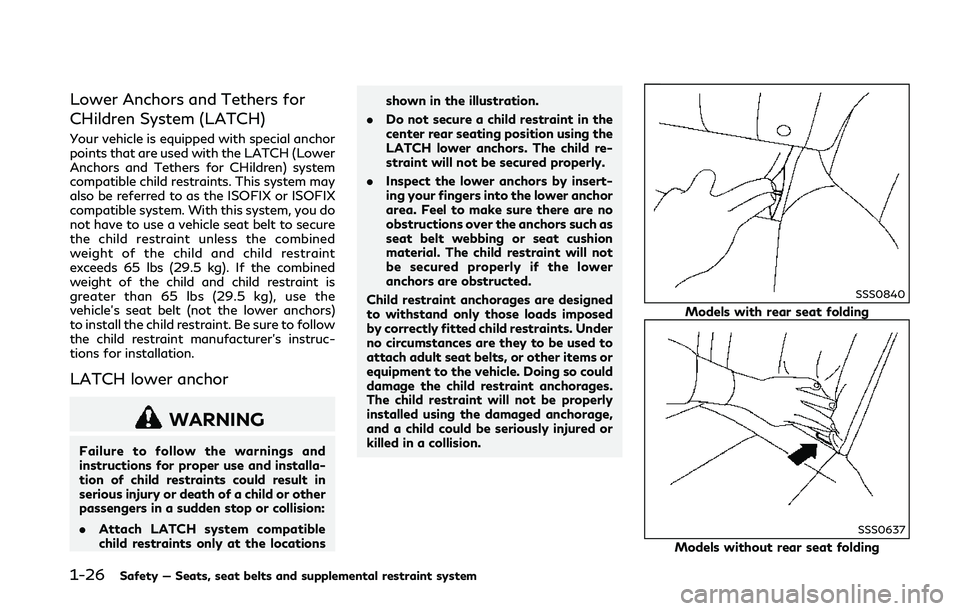
1-26Safety — Seats, seat belts and supplemental restraint system
Lower Anchors and Tethers for
CHildren System (LATCH)
Your vehicle is equipped with special anchor
points that are used with the LATCH (Lower
Anchors and Tethers for CHildren) system
compatible child restraints. This system may
also be referred to as the ISOFIX or ISOFIX
compatible system. With this system, you do
not have to use a vehicle seat belt to secure
the child restraint unless the combined
weight of the child and child restraint
exceeds 65 lbs (29.5 kg). If the combined
weight of the child and child restraint is
greater than 65 lbs (29.5 kg), use the
vehicle’s seat belt (not the lower anchors)
to install the child restraint. Be sure to follow
the child restraint manufacturer’s instruc-
tions for installation.
LATCH lower anchor
WARNING
Failure to follow the warnings and
instructions for proper use and installa-
tion of child restraints could result in
serious injury or death of a child or other
passengers in a sudden stop or collision:
.Attach LATCH system compatible
child restraints only at the locations shown in the illustration.
. Do not secure a child restraint in the
center rear seating position using the
LATCH lower anchors. The child re-
straint will not be secured properly.
. Inspect the lower anchors by insert-
ing your fingers into the lower anchor
area. Feel to make sure there are no
obstructions over the anchors such as
seat belt webbing or seat cushion
material. The child restraint will not
be secured properly if the lower
anchors are obstructed.
Child restraint anchorages are designed
to withstand only those loads imposed
by correctly fitted child restraints. Under
no circumstances are they to be used to
attach adult seat belts, or other items or
equipment to the vehicle. Doing so could
damage the child restraint anchorages.
The child restraint will not be properly
installed using the damaged anchorage,
and a child could be seriously injured or
killed in a collision.
SSS0840
Models with rear seat folding
SSS0637
Models without rear seat folding
Page 46 of 458
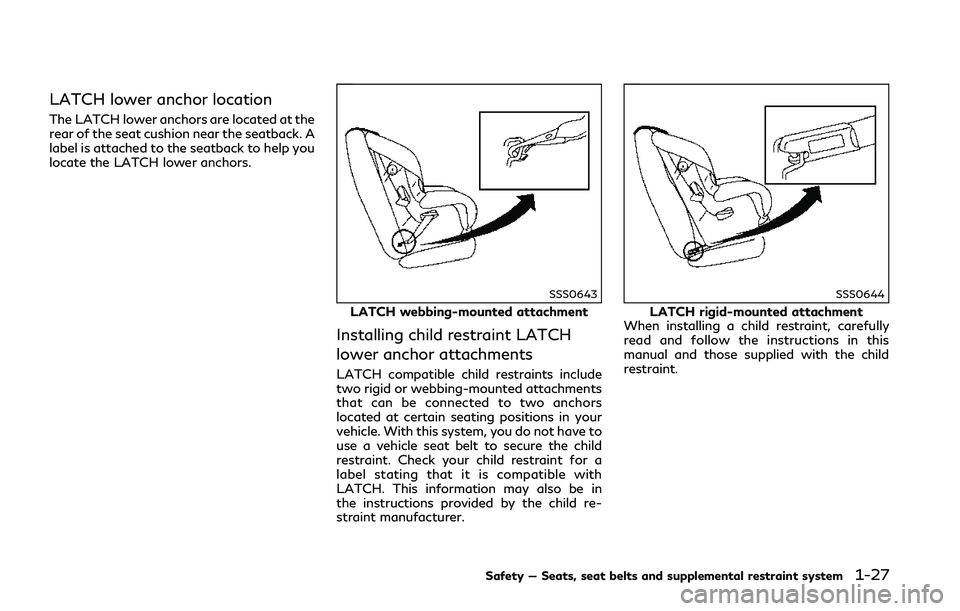
LATCH lower anchor location
The LATCH lower anchors are located at the
rear of the seat cushion near the seatback. A
label is attached to the seatback to help you
locate the LATCH lower anchors.
SSS0643
LATCH webbing-mounted attachment
Installing child restraint LATCH
lower anchor attachments
LATCH compatible child restraints include
two rigid or webbing-mounted attachments
that can be connected to two anchors
located at certain seating positions in your
vehicle. With this system, you do not have to
use a vehicle seat belt to secure the child
restraint. Check your child restraint for a
label stating that it is compatible with
LATCH. This information may also be in
the instructions provided by the child re-
straint manufacturer.
SSS0644
LATCH rigid-mounted attachment
When installing a child restraint, carefully
read and follow the instructions in this
manual and those supplied with the child
restraint.
Safety — Seats, seat belts and supplemental restraint system1-27
Page 47 of 458
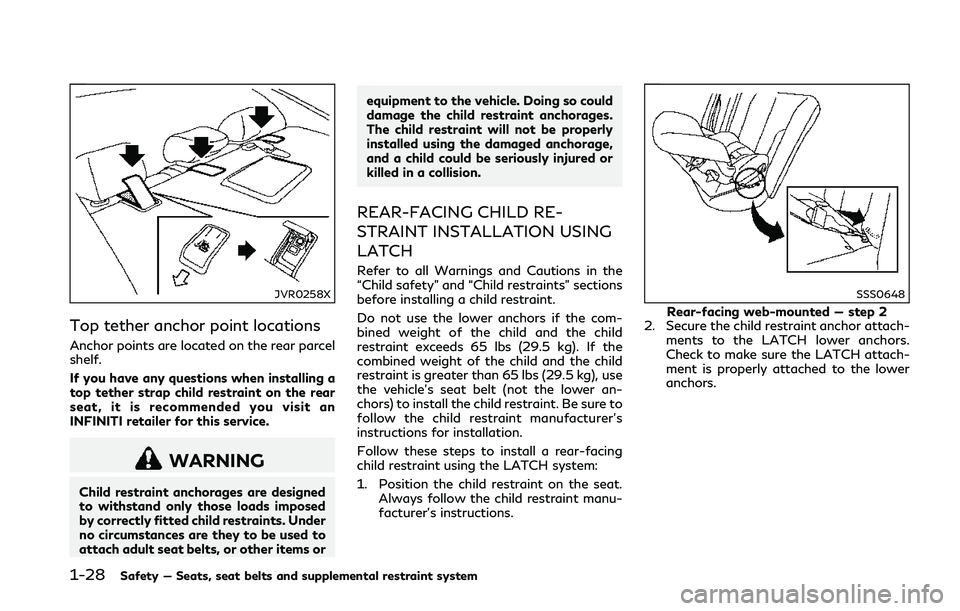
1-28Safety — Seats, seat belts and supplemental restraint system
JVR0258X
Top tether anchor point locations
Anchor points are located on the rear parcel
shelf.
If you have any questions when installing a
top tether strap child restraint on the rear
seat, it is recommended you visit an
INFINITI retailer for this service.
WARNING
Child restraint anchorages are designed
to withstand only those loads imposed
by correctly fitted child restraints. Under
no circumstances are they to be used to
attach adult seat belts, or other items orequipment to the vehicle. Doing so could
damage the child restraint anchorages.
The child restraint will not be properly
installed using the damaged anchorage,
and a child could be seriously injured or
killed in a collision.
REAR-FACING CHILD RE-
STRAINT INSTALLATION USING
LATCH
Refer to all Warnings and Cautions in the
“Child safety” and “Child restraints” sections
before installing a child restraint.
Do not use the lower anchors if the com-
bined weight of the child and the child
restraint exceeds 65 lbs (29.5 kg). If the
combined weight of the child and the child
restraint is greater than 65 lbs (29.5 kg), use
the vehicle’s seat belt (not the lower an-
chors) to install the child restraint. Be sure to
follow the child restraint manufacturer’s
instructions for installation.
Follow these steps to install a rear-facing
child restraint using the LATCH system:
1. Position the child restraint on the seat.
Always follow the child restraint manu-
facturer’s instructions.
SSS0648
Rear-facing web-mounted — step 2
2. Secure the child restraint anchor attach-
ments to the LATCH lower anchors.
Check to make sure the LATCH attach-
ment is properly attached to the lower
anchors.
Page 48 of 458
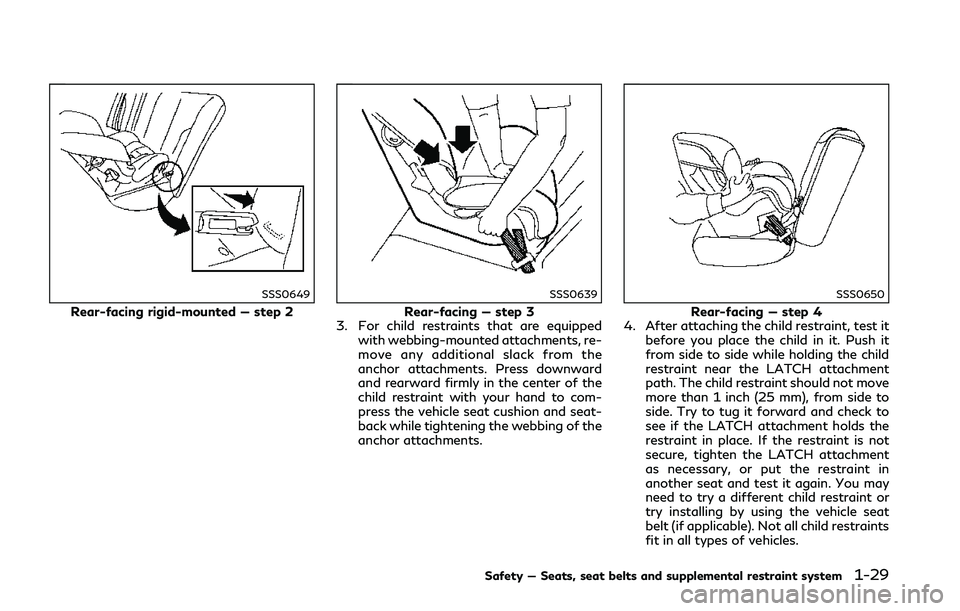
SSS0649
Rear-facing rigid-mounted — step 2
SSS0639
Rear-facing — step 3
3. For child restraints that are equipped
with webbing-mounted attachments, re-
move any additional slack from the
anchor attachments. Press downward
and rearward firmly in the center of the
child restraint with your hand to com-
press the vehicle seat cushion and seat-
back while tightening the webbing of the
anchor attachments.
SSS0650
Rear-facing — step 4
4. After attaching the child restraint, test it
before you place the child in it. Push it
from side to side while holding the child
restraint near the LATCH attachment
path. The child restraint should not move
more than 1 inch (25 mm), from side to
side. Try to tug it forward and check to
see if the LATCH attachment holds the
restraint in place. If the restraint is not
secure, tighten the LATCH attachment
as necessary, or put the restraint in
another seat and test it again. You may
need to try a different child restraint or
try installing by using the vehicle seat
belt (if applicable). Not all child restraints
fit in all types of vehicles.
Safety — Seats, seat belts and supplemental restraint system1-29
Page 49 of 458
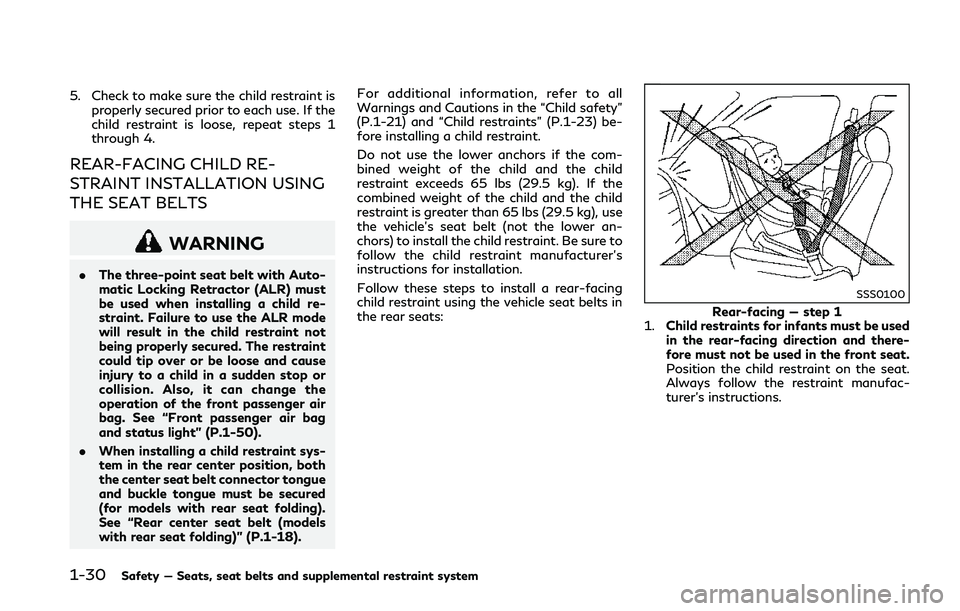
1-30Safety — Seats, seat belts and supplemental restraint system
5. Check to make sure the child restraint isproperly secured prior to each use. If the
child restraint is loose, repeat steps 1
through 4.
REAR-FACING CHILD RE-
STRAINT INSTALLATION USING
THE SEAT BELTS
WARNING
.The three-point seat belt with Auto-
matic Locking Retractor (ALR) must
be used when installing a child re-
straint. Failure to use the ALR mode
will result in the child restraint not
being properly secured. The restraint
could tip over or be loose and cause
injury to a child in a sudden stop or
collision. Also, it can change the
operation of the front passenger air
bag. See “Front passenger air bag
and status light” (P.1-50).
. When installing a child restraint sys-
tem in the rear center position, both
the center seat belt connector tongue
and buckle tongue must be secured
(for models with rear seat folding).
See “Rear center seat belt (models
with rear seat folding)” (P.1-18). For additional information, refer to all
Warnings and Cautions in the “Child safety”
(P.1-21) and “Child restraints” (P.1-23) be-
fore installing a child restraint.
Do not use the lower anchors if the com-
bined weight of the child and the child
restraint exceeds 65 lbs (29.5 kg). If the
combined weight of the child and the child
restraint is greater than 65 lbs (29.5 kg), use
the vehicle’s seat belt (not the lower an-
chors) to install the child restraint. Be sure to
follow the child restraint manufacturer’s
instructions for installation.
Follow these steps to install a rear-facing
child restraint using the vehicle seat belts in
the rear seats:
SSS0100
Rear-facing — step 1
1. Child restraints for infants must be used
in the rear-facing direction and there-
fore must not be used in the front seat.
Position the child restraint on the seat.
Always follow the restraint manufac-
turer’s instructions.
Page 50 of 458
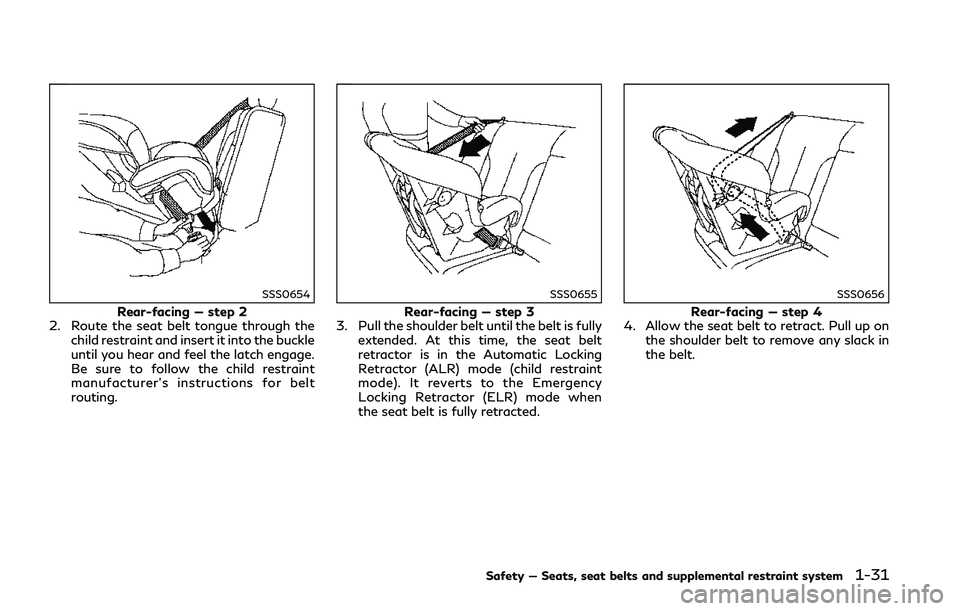
SSS0654
Rear-facing — step 2
2. Route the seat belt tongue through the
child restraint and insert it into the buckle
until you hear and feel the latch engage.
Be sure to follow the child restraint
manufacturer’s instructions for belt
routing.
SSS0655
Rear-facing — step 3
3. Pull the shoulder belt until the belt is fully
extended. At this time, the seat belt
retractor is in the Automatic Locking
Retractor (ALR) mode (child restraint
mode). It reverts to the Emergency
Locking Retractor (ELR) mode when
the seat belt is fully retracted.
SSS0656
Rear-facing — step 4
4. Allow the seat belt to retract. Pull up on
the shoulder belt to remove any slack in
the belt.
Safety — Seats, seat belts and supplemental restraint system1-31